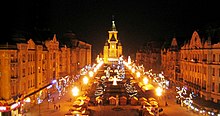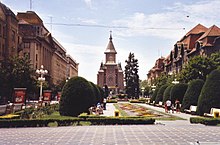Piața Victoriei (Timișoara)
The Piața Victoriei ( German Victory Square ), also called Piața Operei (Eng. Opera Square ), is a square in today's city center of the western Romanian city of Timișoara . It is considered to be the most famous promenade in the city.
history
Originally, the fortress walls ran around the old core of the inner city ( Romanian Cetate ) at the level of today's State Theater . In the place of today's Piața Victoriei, an avenue used to run into Josefstadt. The area was still part of the fortress foreland in the 19th century, this so-called esplanade was not allowed to be built on for strategic reasons.
At the beginning of the 20th century was Bastion finally torn after razing the ramparts , the fortress foreshore in 1905 turned into urban possession. The avenue in the Josefstadt was straightened and widened, from 1910 a modern boulevard was built , flanked by upper-class residential palaces. Originally a radial urban district up to the - now canalised - Bega was planned . This would have been completed by a new ring road based on the Viennese model. The square that was created at the time was designed as a new city center. In fact, these plans were only partially implemented, in the south of the Piața Victoriei there are extensive parks - large parts of the fortress foothills are still undeveloped.
In 1923 the square was extensively rebuilt. From then on, the tram tracks ran separately according to the direction of travel at a distance of 30 meters from one another, and today's green space was built in the middle. However, the latter has been redesigned several times over the years.
In the mid-1980s, private transport was banned from the forecourt of the opera, and the underpass that was once there was closed. In the summer of 1989, the local tram was finally relocated to parallel streets, and Piața Victoriei has been a pedestrian zone ever since .
During the Romanian Revolution of 1989 , which led to the violent overthrow of the regime under Nicolae Ceaușescu , today's Piața Victoriei was a central scene of the first mass demonstrations and bloody unrest. Among other things, the revolutionaries made their speeches from the balcony of the opera. Even today (as of 2009) bullet holes can be seen in the facades of the houses on the left and right of the magnificent mile. Next to the theater, a simple wooden cross, burning candles and flowers remind of the victims of the uprising.
description
The elongated Piața Victoriei lies between the Romanian Orthodox Cathedral of the Three Holy Hierarchs and the National Theater and Opera House (with the German State Theater and the Hungarian State Theater), which are a little over 350 meters apart. The square is lined with varied architecture in the Baroque , Vienna Secession and Romanian Neo- Brâncoveanu styles . Numerous shops and street cafes, as well as pavement gardens in summer, are located here.
On both sides of the wide square are some of the most famous city palaces. Coming from the opera and looking towards the Orthodox Cathedral, the first building on the right is the Hotel Timișoara , which was built as Pension Central according to the plans of the architects László Székely and Mathias Hubert between 1928 and 1929. This is followed by the Palais Weiss , which was built in 1912. The Palais Lloyd was built between 1910 and 1912 according to the plans of the architect Lipót Baumhorn . Today it is the seat of the rectorate of the Polytechnic University . The Lloyd Restaurant is on the ground floor. The Neuhaus Palace was built by László Székely with influences from Hungarian Art Nouveau . The Palais Merbl was built according to plans by the architect Arnold Merbl . The Dauerbach Palace was built for Georg Dauerbach in 1913 according to plans by László Székely . The Hilt & Vogel Palace was built between 1912 and 1913 according to plans by László Székely. The Széchényi Society had the Széchényi Palace built between 1900 and 1914 according to the plans of László Székely.
The first building to be found on the left side of the square is the Löffler Palace , which the Löffler family had built between 1912 and 1913. The Chamber of Commerce Palais was established by imperial decree in 1850 and built by László Székely in 1933. The development of the Piața Victoriei was not completed until 1961 to 1963. At that time, two modern residential and commercial buildings were built between the cathedral and the Chamber of Commerce; they closed the decades-long vacant lot in this area.
In the middle part a park-like garden with flowers, avenues and benches was created. There are three monuments here, such as the fish fountain , which was built in the shape of a pentagonal star in 1957. The name comes from the fish that let the water splash through their mouths. The next monument is the statue of a Capitoline wolf suckling Romulus and Remus on a five meter high column. It is a copy of the Roman original and a gift from the city of Rome on April 23, 1926 to the inhabitants of the city as an allegory of their Latin character. The third monument, a sculpture dedicated to the victims of the revolution of December 1989 called Crucificarea ( German crucifixion ), is the work of the artist Paul Neagu and is located opposite the cathedral. In December 2009, memorial plaques with the names of the victims of the revolution were unveiled near the cross.
The following diagram shows the arrangement of the buildings on the square, along with the respective year of construction:
 Modex fashion house in 1971 |
parking spot |
 Palais Löffler 1912 |
 Chamber of Commerce palace 1933 |
 Residential and business house in 1961 |
 Residential and commercial building in 1961 |
 Parcul Justiției with the Banat Philharmonic |
|||||||||
| Strada Alba Iulia | Bd. Regele Ferdinand | ||||||||||||||
 Opera 1871 |
 Fish fountain 1957 |
 Capitoline Wolf 1926 |
Sculpture Crucificarea 1990 |
 Cathedral 1936 |
|||||||||||
| Strada Mărăşeşti | Vol. Carol Rule I | ||||||||||||||
 Hotel Timisoara 1928 |
Palais Weiss 1912 |
 Palais Lloyd 1910 |
 Palais Neuhaus 1912 |
 Palais Merbl 1911 |
 Palais Dauerbach 1911 |
 Palais Hilt & Vogel 1912 |
 Széchényi Palace 1900 |
 Parcul Central |
|||||||
Name of the place
Originally the undeveloped avenue was part of the long Hunyadi út , this began at the theater and led far into the Josefstadt. Around 1910 the names were split up and the current square was called Ferencz József út for several years . Only shortly afterwards it was renamed Ferdinánd király út or Ferdinánd király kőrút , in the interwar period it was then called Bulevardul Regele Ferdinand . Named here was the Austrian emperor and Hungarian King Ferdinand I .
In the socialist era the square was called Bulevardul 30 Decembrie from 1948 ; eponymous was the abdication of the Romanian King Michael the First on December 30, 1947. In memory of the events of the Romanian Revolution, he was finally given his current name Piața Victoriei at the beginning of the 1990s.
In the German population , the square is traditionally also called Lloyd -zeile , based on the Palais Lloyd there , similarly to the Hungarian population as Lloyd sor .
Another slang term for the square is Corso (German: Korso , Hungarian: Korzó ). The left side of the square as seen in the direction of the cathedral is also known as Surogat (German: Ersatz, Ersatzkorso ).
literature
- Dan N. Buruleanu, Florin Mendeleț: Timișoara. Povestea orașelor sale. The history of its cities . Mirton, Timișoara 2004, ISBN 973-661-276-7 (Romanian).
- Dinu Barbu: I love Timişoara, Editura Almanahul Banatului, ediţia V . 2006, ISBN 973-8091-30-6 .
Web links
- Dorin.Devalvr.com , 360 ° view of the Piata Victoriei (requires Apple - Plug-in )
- Rumaenien-Info.at , Piața Victoriei, Timișoara
Remarks
- ↑ Petru Ilieșu names the sculpture The Broken Cross ( Romanian Crucea ruptă ) in his book , see A tourist in Timișoara - Tourist in Timisoara. Planetarium, Timișoara 2008, ISBN 978-973-108-154-0 .
Individual evidence
- ↑ Ryan James, Hana Mastrini, Mark Baker, Karen Torme Olson, Angela Charlton, Keith Bain, Pippa de Bruyn: Frommer's Eastern Europe, Issue 655 of Frommer's Complete . John Wiley and Sons, Hoboken, NJ 2009, ISBN 978-0-470-39908-8 , pp. 736 (English).
- ↑ WhatsYourPlace.de ( Memento of 3 December 2009 at the Internet Archive ), Piata Victoriei Timisoara
- ↑ TripWolf.com , Lloyd Line (Piața Victoriei)
- ↑ Walter M. Weiss: Temesvar was formerly called "Little Vienna" ( Memento of November 7, 2005 in the Internet Archive ) In: Wiener Zeitung .
- ^ Petru Ilieșu: A tourist in Timișoara - Tourist in Timişoara. Planetarium, Timișoara, 2008, ISBN 978-973-108-154-0 .
- ↑ 20deanidelibertate.primariatm.ro , Program pentru comemorarea a 20 de ani de la-revoluția Română din Decembrie 1989. (Romanian)
- ↑ Darastean.com ( Memento of 2 September 2006 at the Internet Archive ), Public Timişoara portfolio. (English)
- ^ Hans-Heinrich Rieser: Timisoara: geographical description of the Banat capital . Franz Steiner Verlag, Stuttgart 1992, ISBN 3-515-08288-3 , pp. 152 .
- ↑ PrimariaTM.ro , Corso va fi reabilitat , September 2009. (Romanian)
- ↑ Qype.com , Piața Victoriei, Timișoara
Coordinates: 45 ° 45 ′ 11.7 ″ N , 21 ° 13 ′ 32 ″ E








